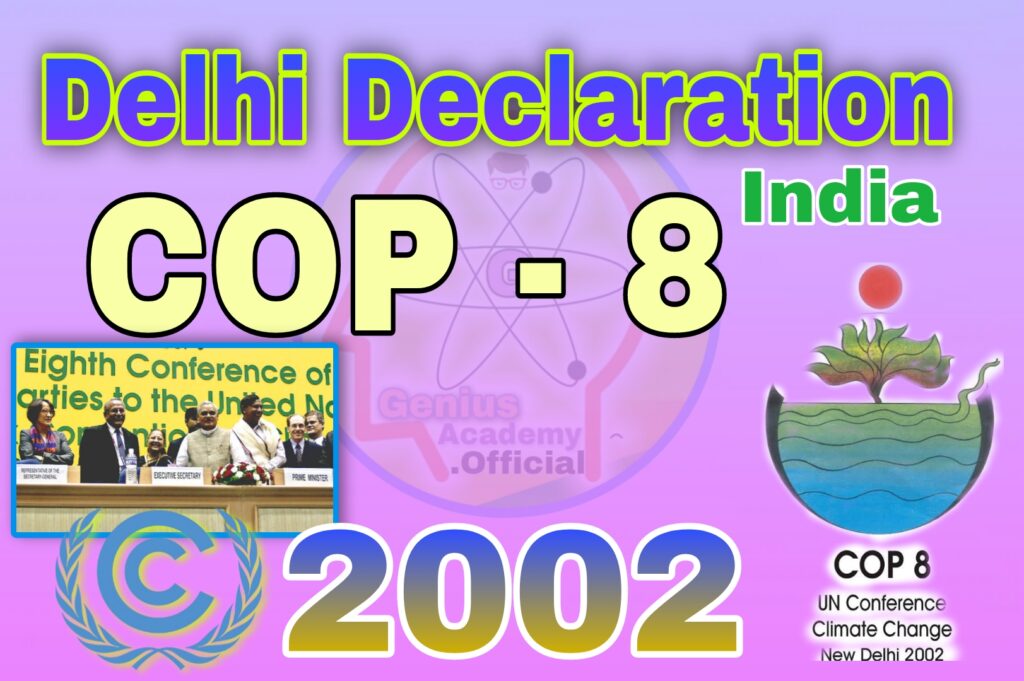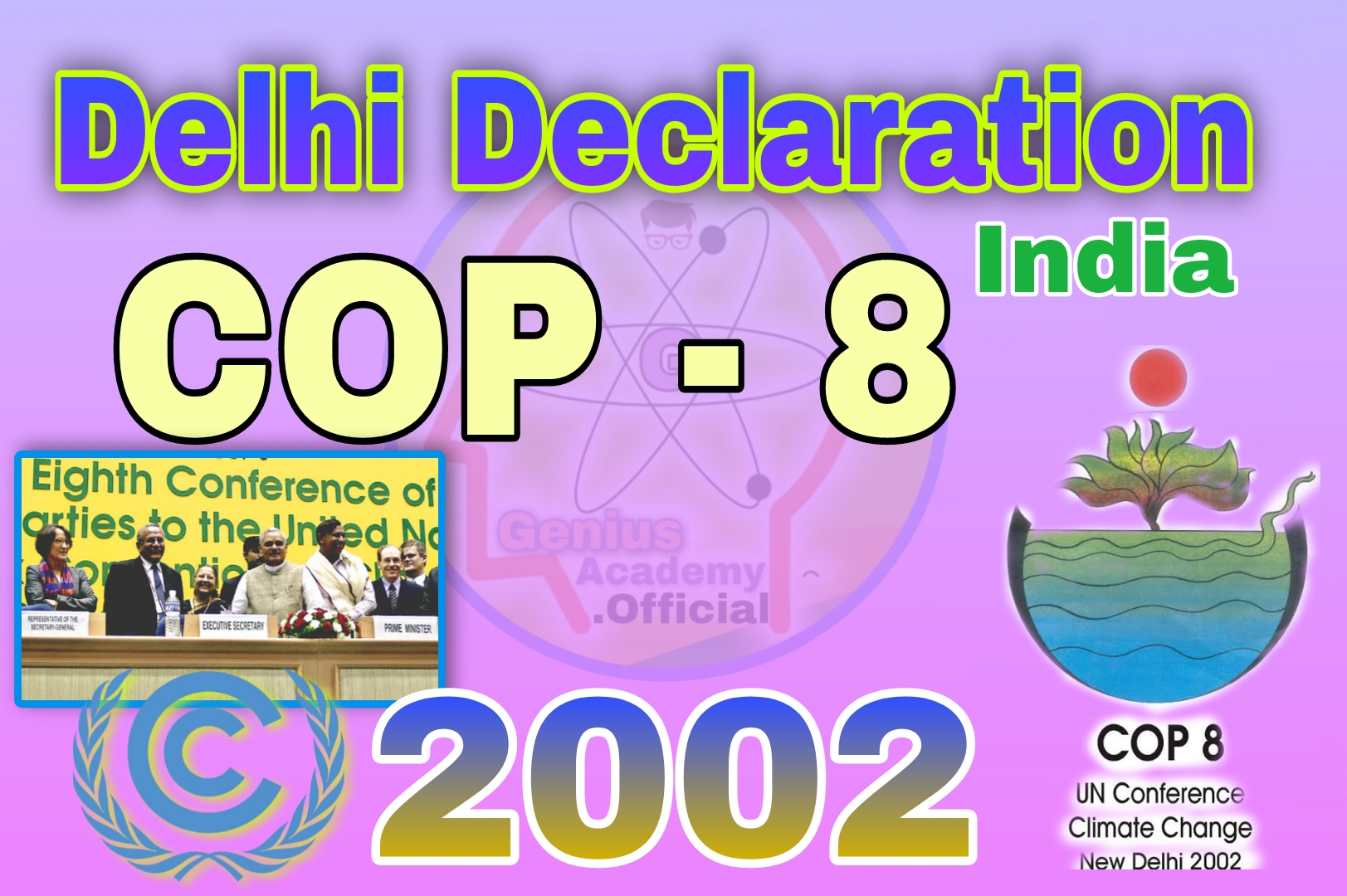
COP-8 Conference in New Delhi: Key Highlights and Statements
The Eighth Conference of the Parties (COP-8) to the United Nations Framework Convention on Climate Change (UNFCCC) took place in New Delhi, India, in October 2002. This conference was significant for advancing global climate negotiations, with a particular focus on the role of developing countries in climate action. Indian Prime Minister Atal Behari Vajpayee’s remarks at the ministerial segment emphasized the unique challenges faced by developing nations in reducing greenhouse gas (GHG) emissions. His statement highlighted the ongoing debate over the responsibilities of developing versus developed countries in addressing climate change.
Prime Minister Vajpayee’s Key Points on Climate Responsibility
1. Differentiated Emission Targets for Developing Countries
- Argument Against Uniform Targets:— Prime Minister Vajpayee argued that developing countries should not be subject to the same GHG reduction targets as developed countries. He stressed that developing nations contribute only a small fraction of the world’s total emissions, and imposing uniform reduction obligations would unfairly strain their economies.
- Financial Constraints:— Developing nations face significant economic challenges and limited resources, making it difficult to prioritize emissions reductions without jeopardizing their economic growth and poverty alleviation efforts.
2. Per Capita Emissions Disparity
- Lower Emissions Levels:— Vajpayee pointed out that per capita GHG emissions in developing countries, such as India, are substantially lower than those in developed nations. He emphasized that this gap in emissions levels would persist for decades, given the economic disparity.
- Justification for Different Responsibilities:— Given the lower per capita emissions, Vajpayee argued that it would be unreasonable to impose the same mitigation expectations on developing nations as on developed ones, which have historically contributed more to climate change.
3. Economic Impact on Developing Countries
- Climate Mitigation and Economic Growth:— Climate change mitigation measures would place additional strain on the already fragile economies of developing nations. According to Vajpayee, these measures could hinder GDP growth, undermining efforts to eradicate poverty quickly.
- Balancing Development and Environmental Responsibility:— Vajpayee stressed the need for developing countries to prioritize economic growth to improve living standards and reduce poverty. Forcing these countries to adopt costly mitigation measures would delay their progress toward sustainable economic development.
4. Recognition of Developing Countries’ Needs and Aspirations
- Focus on Sustainable Development:— The Delhi Declaration highlighted the need to address climate change within a framework that allows for sustainable development, reflecting a balanced approach to environmental protection and economic growth. This approach resonated strongly with developing countries, who prioritize poverty alleviation, economic development, and energy access alongside environmental goals.
- Support from Developing Nations:— Leaders and representatives from developing nations praised the Declaration, acknowledging its alignment with their needs. As Nigeria’s delegate, Mohammed Sanusi Barkindo, expressed, the declaration recognized “the need and aspirations of the developing world.” Similarly, the Chinese delegation noted that this approach was effective in addressing climate change while supporting their development priorities.
5. Symbolic Importance for Developing Countries
- Substantive and Symbolic Victory:— For many developing countries, the declaration was more than a policy document; it was a symbolic affirmation of their unique position in global climate talks. By incorporating sustainable development into climate goals, the Delhi Declaration provided these nations with a sense of inclusion and representation in the climate discourse.
The Kyoto Protocol and the Role of Developing Nations
Implementation Path for the Kyoto Protocol
- Target for Developed Nations:— COP-8 discussions centered on the implementation of the Kyoto Protocol, which mandates that developed countries reduce their GHG emissions to 5.2% below 1990 levels by 2012. The protocol, however, does not require developing nations to meet specific emissions reduction targets.
- Exclusion of Developing Nations:— The Protocol’s design acknowledges the economic and development challenges faced by developing countries. Consequently, it does not impose binding targets on them, reflecting the principle of “common but differentiated responsibilities.”
The Delhi Declaration: Divisions and Points of Contention
- Drafting the Declaration:— One of COP-8’s primary outcomes was the creation of the “Delhi Declaration,” a document meant to guide the next steps in climate action. However, delegates were divided over its content, especially regarding the mention of the Kyoto Protocol.
- Omission of the Kyoto Protocol in Draft Text:— The current draft of the Delhi Declaration did not reference the Kyoto Protocol explicitly, leading to differing views among participants. Some parties wanted stronger references to the Protocol, while others focused on broader climate goals that did not emphasize Kyoto commitments.
The Delhi Declaration: Importance of COP-8 for Developing Countries
The Delhi Declaration, adopted at the Eighth Conference of the Parties (COP-8) to the United Nations Framework Convention on Climate Change (UNFCCC), held both practical and symbolic importance, particularly for developing nations. This declaration emphasized climate change solutions within the context of sustainable development, a stance that aligned with the priorities of many developing countries. However, the declaration also sparked curiosity and controversy, particularly regarding the role of the United States and the unexpected acknowledgment of COP-8 President Baalu.
COP-8 underscored the ongoing debate over climate responsibilities between developed and developing countries. Prime Minister Vajpayee’s address highlighted the need for a balanced approach to climate action that recognizes the historical contributions and economic limitations of each country. By advocating for differentiated responsibilities, developing nations like India emphasized the importance of sustainable economic growth alongside environmental commitments.
Unresolved Mysteries and Controversies
1. The United States’ Support for the Declaration
- An Uncharacteristic Approval:— Despite the U.S.’s rejection of the Kyoto Protocol, it did not oppose the Delhi Declaration. This support raised questions, as the U.S. had previously distanced itself from the Kyoto process, which included legally binding commitments for developed nations to reduce greenhouse gas emissions.
- Speculations on U.S. Motivation:— Rumors circulated that the U.S. found the Delhi Declaration’s language sufficiently non-committal and therefore preferable to a more binding or aggressive stance. A weaker declaration aligned with the U.S. position, allowing it to endorse the document without compromising its opposition to the Kyoto Protocol.
2. Unusual Acknowledgment of COP-8 President Baalu
- Special Mention in the Declaration:— The declaration text included a specific mention thanking COP-8 President Baalu for his leadership. This was unusual, as COP declarations rarely mention individual leaders by name.
- Questions on Leadership:— Observers found the mention curious, as Baalu’s leadership had come under scrutiny during the conference. Some critics argued that Baalu had not provided a clear vision for COP-8’s outcome, making the acknowledgment all the more surprising. This acknowledgment, lacking precedent, led to speculation about its intent and raised questions about his influence on the final declaration.
The Legacy of the Delhi Declaration
The Delhi Declaration marked a significant step for developing nations in the global climate dialogue, emphasizing a climate strategy rooted in sustainable development. It symbolized the aspirations of the developing world to address climate change without compromising their growth. However, the circumstances surrounding the declaration—particularly U.S. approval and the recognition of President Baalu—introduced a layer of intrigue. Ultimately, the declaration highlighted ongoing tensions in international climate negotiations and underscored the complexities of balancing diverse global priorities within a single framework.

